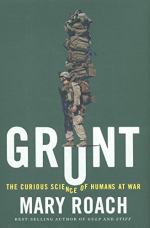|
This section contains 670 words (approx. 2 pages at 400 words per page) |

|
Grunt: The Curious Science of Humans at War Summary & Study Guide Description
Grunt: The Curious Science of Humans at War Summary & Study Guide includes comprehensive information and analysis to help you understand the book. This study guide contains the following sections:
This detailed literature summary also contains Topics for Discussion on Grunt: The Curious Science of Humans at War by Mary Roach.
The following version of this book was used to create this study guide: Roach, Mary. Grunt: The Curious Science of Humans at War. W.W. Norton and Company, Inc., 2016. First Edition.
The book’s considerations of just a few of the challenges facing military service people are developed in a language that is both scientifically explicit and conversationally engaging, with frequent present-tense narration accompanied by interjections of sardonic humor and occasional glimpses of somewhat deeper, emotionally resonant contemplations of what it means to be a soldier … or, in several cases, what it means to be someone who works to both keep soldiers alive, and honor their sacrifice when they are dead.
The author begins her analysis with an introduction that outlines some of the principles of her investigation, most significantly the idea that there are a number of situations faced by military personnel every day that the general public (who, the author suggests, tend to think of military service primarily – solely? – in terms of combat) might not be aware of. This, she comments, is one of the reasons why she did not devote a chapter to experiences of, and treatments for, PTSD (Post Traumatic Stress Disorder): “not because PTSD doesn’t deserve coverage but because it has had so much, and so much of it is so very good” (16). At the conclusion of the introduction, the author also introduces one of the book’s key themes, one related to the idea that there is more to military service than combat. This is the idea that there are different kinds of heroes, and that the courage to commit to, and undertake, scientific exploration is arguably on a par with the courage that it takes to go onto a battlefield.
With the first chapter, in which she explores the science behind the need to develop different types of fabric and clothing to put into military service-wear, the author establishes a structural pattern that tends to form the narrative foundation of each chapter that follows, with slight variations. She introduces a concept with a particular image evoking that concept; describes and defines the scientific background of the concept; explores the history of the concept (which tends to be a particular situation faced by military personnel); and then explores the ways in which scientific research is deployed to find a solution to the difficulties associated with particular situations arising from that concept. She considers circumstances such as how riding in a tank attacked from underneath by an IED (Improvised Explosive Device) can prove damaging to the feet and spines of those riding in it; how serving in a very hot environment without being able to sweat properly can become debilitating; and how suffering from a gastro-intestinal disorder such as diarrhea can disable a field soldier before he or she sets foot into a combat zone.
The author also explores some unusual ways in which a seemingly dangerous scientific reality, or truth, can have an unexpectedly positive side. A particularly vivid example of this is her consideration of how maggots, or the larvae of flies, can be useful in speeding up the healing of deep flesh wounds. In a similar vein, but on an entirely different level, she explores how military-oriented science has put a great deal of effort into finding ways to disorient enemy combatants with bad smells.
Throughout the book, the author explores the contributions of individuals in the scientific community to the general health and well-being of military personnel. She considers discoveries made during conflicts as far back in American history as the Civil War, drawing clear connections between the scientists working then and those working in the aftermath of American wars in Afghanistan and Iraq. As she explores this side of the relationship between science and the military, she deepens the book’s consideration of the central theme outlined in the first paragraph above – the idea that scientific research can lead to, benefit from, and be defined by heroic, sometimes self-sacrificing actions in the same way as military service.
Read more from the Study Guide
|
This section contains 670 words (approx. 2 pages at 400 words per page) |

|



